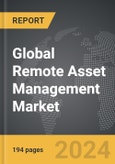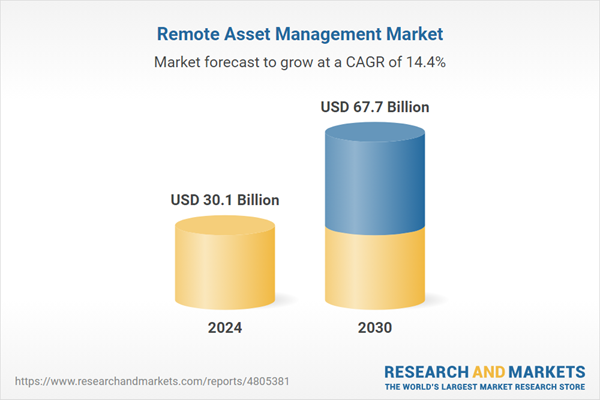Global Remote Asset Management Market - Key Trends and Drivers Summarized
Remote Asset Management: Enhancing Efficiency and Control
Remote asset management is becoming increasingly essential for businesses across various industries, as it enables organizations to monitor, manage, and maintain their assets from a distance. This technology leverages IoT (Internet of Things) devices, sensors, and cloud-based platforms to provide real-time data on the condition, location, and performance of assets, ranging from machinery and vehicles to infrastructure and equipment. By providing remote access to critical asset information, businesses can optimize maintenance schedules, reduce downtime, improve operational efficiency, and enhance decision-making processes. Remote asset management is particularly valuable in industries such as manufacturing, logistics, energy, and utilities, where assets are often dispersed across wide geographic areas and require continuous monitoring to ensure optimal performance and longevity.What Technological Innovations Are Shaping the Remote Asset Management Market?
Technological innovations are playing a pivotal role in shaping the remote asset management market, driving the adoption of more advanced, efficient, and integrated solutions. One of the key trends is the increasing use of IoT technology, which allows for the seamless integration of sensors and devices with cloud-based management platforms. This connectivity enables real-time data collection and analysis, providing businesses with actionable insights into asset performance and health. Additionally, the integration of AI (artificial intelligence) and machine learning algorithms into remote asset management systems is enhancing predictive maintenance capabilities, allowing businesses to anticipate and address potential issues before they lead to costly breakdowns or downtime. The development of advanced analytics and reporting tools is also contributing to the market by enabling more informed decision-making and optimizing asset utilization. Moreover, the growing adoption of 5G technology is expected to further enhance remote asset management by providing faster, more reliable connectivity, supporting the real-time monitoring and control of assets across large-scale operations.What Are the Key Applications and Benefits of Remote Asset Management?
Remote asset management is used in a wide range of industries, offering significant benefits that enhance operational efficiency, reduce costs, and improve asset performance. In the manufacturing sector, remote asset management enables businesses to monitor machinery and equipment in real-time, ensuring that maintenance is conducted at optimal intervals and reducing the risk of unexpected breakdowns. In the logistics and transportation industry, remote asset management is used to track the location and condition of vehicles and cargo, optimizing routing and delivery schedules while ensuring compliance with regulatory requirements. The energy and utilities sector also relies on remote asset management to monitor critical infrastructure, such as pipelines, power lines, and wind turbines, enabling timely maintenance and reducing the risk of failures. The primary benefits of remote asset management include improved asset visibility, enhanced operational efficiency, reduced maintenance costs, and extended asset lifespan. These advantages make remote asset management an essential tool for businesses seeking to optimize their operations and maximize the value of their assets.What Factors Are Driving the Growth in the Remote Asset Management Market?
The growth in the Remote Asset Management market is driven by several factors. The increasing adoption of IoT technology across various industries is a significant driver, as businesses seek to leverage real-time data to improve asset performance and operational efficiency. Technological advancements, particularly in AI, machine learning, and advanced analytics, are also propelling market growth by enhancing the capabilities and effectiveness of remote asset management solutions. The growing complexity and scale of industrial operations, coupled with the need for continuous monitoring and maintenance, are further boosting demand for remote asset management, as businesses look to minimize downtime and optimize asset utilization. Additionally, the rising focus on sustainability and energy efficiency is contributing to market growth, as remote asset management enables businesses to monitor and reduce their environmental impact. These factors, combined with the continuous innovation in remote monitoring technology and connectivity, are driving the sustained growth of the Remote Asset Management market.Report Scope
The report analyzes the Remote Asset Management market, presented in terms of units. The analysis covers the key segments and geographic regions outlined below.Segments: Component (Solutions, Services); Deployment (On-Premise Deployment, Cloud); Organization Size (Large Enterprises, SMEs); End-Use (Manufacturing, Building Automation, Energy & Utilities, Transportation & Logistics, Healthcare, Retail, Other End-Uses).
Geographic Regions/Countries: World; United States; Canada; Japan; China; Europe (France; Germany; Italy; United Kingdom; and Rest of Europe); Asia-Pacific; Rest of World.
Key Insights:
- Market Growth: Understand the significant growth trajectory of the Solutions segment, which is expected to reach US$39.6 Billion by 2030 with a CAGR of a 14.0%. The Services segment is also set to grow at 15.1% CAGR over the analysis period.
- Regional Analysis: Gain insights into the U.S. market, valued at $8.2 Billion in 2024, and China, forecasted to grow at an impressive 13.3% CAGR to reach $10.2 Billion by 2030. Discover growth trends in other key regions, including Japan, Canada, Germany, and the Asia-Pacific.
Why You Should Buy This Report:
- Detailed Market Analysis: Access a thorough analysis of the Global Remote Asset Management Market, covering all major geographic regions and market segments.
- Competitive Insights: Get an overview of the competitive landscape, including the market presence of major players across different geographies.
- Future Trends and Drivers: Understand the key trends and drivers shaping the future of the Global Remote Asset Management Market.
- Actionable Insights: Benefit from actionable insights that can help you identify new revenue opportunities and make strategic business decisions.
Key Questions Answered:
- How is the Global Remote Asset Management Market expected to evolve by 2030?
- What are the main drivers and restraints affecting the market?
- Which market segments will grow the most over the forecast period?
- How will market shares for different regions and segments change by 2030?
- Who are the leading players in the market, and what are their prospects?
Report Features:
- Comprehensive Market Data: Independent analysis of annual sales and market forecasts in US$ Million from 2024 to 2030.
- In-Depth Regional Analysis: Detailed insights into key markets, including the U.S., China, Japan, Canada, Europe, Asia-Pacific, Latin America, Middle East, and Africa.
- Company Profiles: Coverage of players such as ABACUS PROPERTY MANAGEMENT PTE LTD, AIRSIS, Altair Engineering Finland Oy, Apartment Management Consultants, Artelia and more.
- Complimentary Updates: Receive free report updates for one year to keep you informed of the latest market developments.
Some of the 41 companies featured in this Remote Asset Management market report include:
- ABACUS PROPERTY MANAGEMENT PTE LTD
- AIRSIS
- Altair Engineering Finland Oy
- Apartment Management Consultants
- Artelia
- Azurelope Limited
- Bullet Point Network, L.P.
- Calibrio
- Centrifuge Inc
- cnsec
Tariff Impact Analysis: Key Insights for 2025
Global tariff negotiations across 180+ countries are reshaping supply chains, costs, and competitiveness. This report reflects the latest developments as of April 2025 and incorporates forward-looking insights into the market outlook.The analysts continuously track trade developments worldwide, drawing insights from leading global economists and over 200 industry and policy institutions, including think tanks, trade organizations, and national economic advisory bodies. This intelligence is integrated into forecasting models to provide timely, data-driven analysis of emerging risks and opportunities.
What’s Included in This Edition:
- Tariff-adjusted market forecasts by region and segment
- Analysis of cost and supply chain implications by sourcing and trade exposure
- Strategic insights into geographic shifts
Buyers receive a free July 2025 update with:
- Finalized tariff impacts and new trade agreement effects
- Updated projections reflecting global sourcing and cost shifts
- Expanded country-specific coverage across the industry
Table of Contents
Companies Mentioned (Partial List)
A selection of companies mentioned in this report includes, but is not limited to:
- ABACUS PROPERTY MANAGEMENT PTE LTD
- AIRSIS
- Altair Engineering Finland Oy
- Apartment Management Consultants
- Artelia
- Azurelope Limited
- Bullet Point Network, L.P.
- Calibrio
- Centrifuge Inc
- cnsec
Table Information
| Report Attribute | Details |
|---|---|
| No. of Pages | 194 |
| Published | April 2025 |
| Forecast Period | 2024 - 2030 |
| Estimated Market Value ( USD | $ 30.1 Billion |
| Forecasted Market Value ( USD | $ 67.7 Billion |
| Compound Annual Growth Rate | 14.4% |
| Regions Covered | Global |








